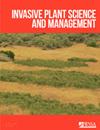Assessing the risk of plant species invasion under different climate change scenarios in California
IF 1.2
4区 生物学
Q3 PLANT SCIENCES
引用次数: 3
Abstract
Abstract Using species distribution models (SDMs), we predicted the distribution of 170 plant species under different climatic scenarios (current and future climatic conditions) and used this information to create invasion risk maps to identify potential invasion hot spots in California. The risk of invasion by individual species was also assessed using species' predicted area in combination with some biological traits associated with invasiveness (growth form, reproduction mechanisms, and age of maturity). A higher number of species would find suitable climatic conditions along the coast; the Central Western (CW) and South Western (SW) were ecoregions where a higher number of species were predicted. Overall, hot spots of species distribution were similar under current and future climatic conditions; however, individual species' predicted area (increase or decrease) was variable depending on the climate change scenario and the greenhouse gas emission. Out of the 170 species assessed, 22% ranked as high-risk species, with herbs, grasses, and vines accounting for 78% within this risk class, and a high proportion (67%) of Asteraceae species ranked as high risk. This study suggests that current climatic conditions of the central and south coastal regions of California would be considered as hot spots of new invasions, and for some species this risk might increase with hotter and drier future climatic conditions.评估加州不同气候变化情景下植物物种入侵的风险
摘要使用物种分布模型(SDM),我们预测了170种植物在不同气候情景(当前和未来气候条件)下的分布,并利用这些信息创建入侵风险图,以确定加州潜在的入侵热点。还使用物种的预测面积以及与入侵性相关的一些生物学特征(生长形式、繁殖机制和成熟年龄)来评估单个物种的入侵风险。更多的物种会在沿海找到合适的气候条件;中西部(CW)和西南部(SW)是预测物种数量较多的生态区。总体而言,在当前和未来的气候条件下,物种分布的热点是相似的;然而,单个物种的预测面积(增加或减少)是可变的,这取决于气候变化情景和温室气体排放。在评估的170个物种中,22%被列为高风险物种,草本、草和藤蔓植物占该风险类别的78%,菊科物种中有高比例(67%)被列为高危物种。这项研究表明,加利福尼亚州中部和南部沿海地区目前的气候条件将被视为新入侵的热点,对一些物种来说,这种风险可能会随着未来气候条件的炎热和干燥而增加。
本文章由计算机程序翻译,如有差异,请以英文原文为准。
求助全文
约1分钟内获得全文
求助全文
来源期刊

Invasive Plant Science and Management
PLANT SCIENCES-
CiteScore
2.20
自引率
9.10%
发文量
24
审稿时长
6-12 weeks
期刊介绍:
Invasive Plant Science and Management (IPSM) is an online peer-reviewed journal focusing on fundamental and applied research on invasive plant biology, ecology, management, and restoration of invaded non-crop areas, and on other aspects relevant to invasive species, including educational activities and policy issues. Topics include the biology and ecology of invasive plants in rangeland, prairie, pasture, wildland, forestry, riparian, wetland, aquatic, recreational, rights-of-ways, and other non-crop (parks, preserves, natural areas) settings; genetics of invasive plants; social, ecological, and economic impacts of invasive plants and their management; design, efficacy, and integration of control tools; land restoration and rehabilitation; effects of management on soil, air, water, and wildlife; education, extension, and outreach methods and resources; technology and product reports; mapping and remote sensing, inventory and monitoring; technology transfer tools; case study reports; and regulatory issues.
 求助内容:
求助内容: 应助结果提醒方式:
应助结果提醒方式:


